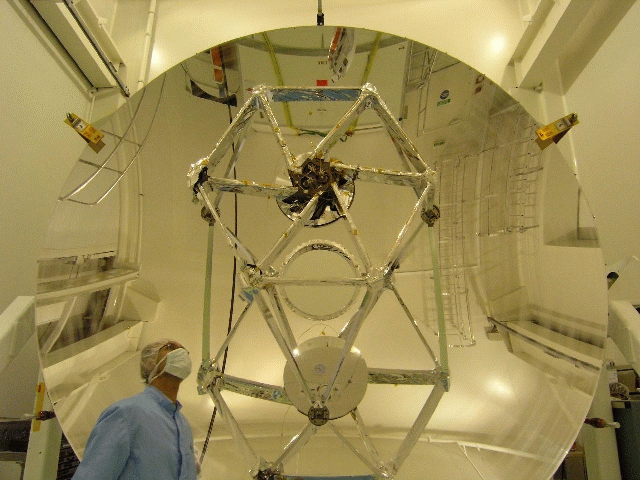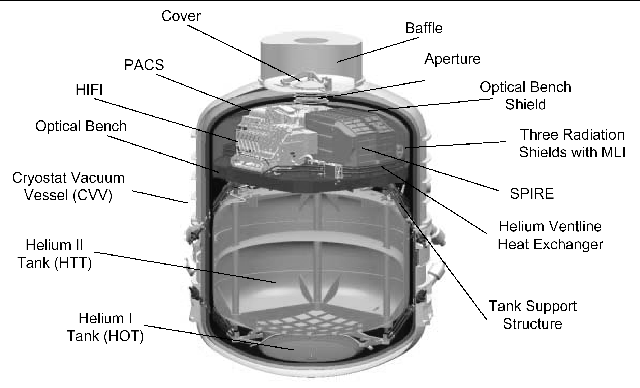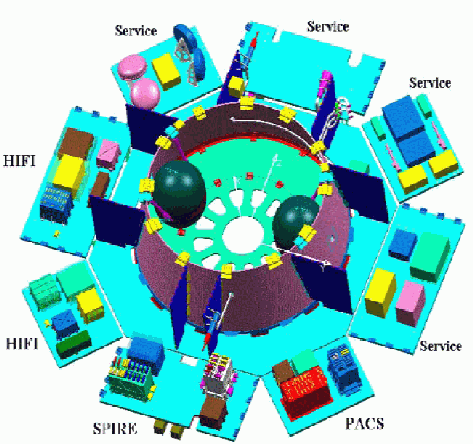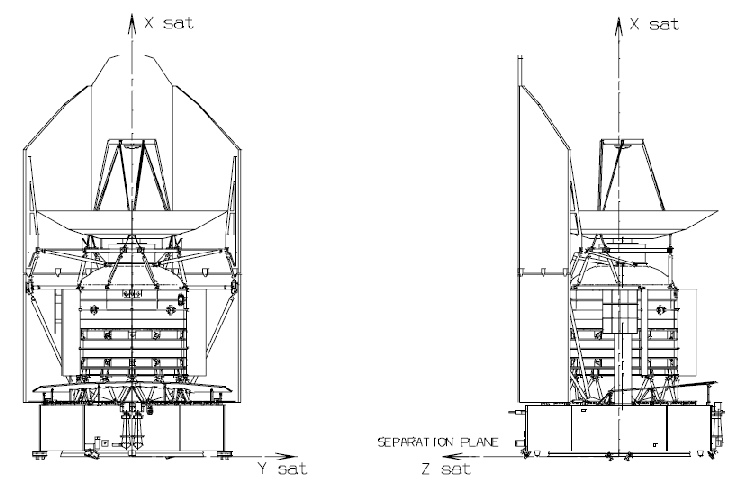Table of Contents
This section summarises the main characteristics of the Herschel spacecraft, its orbit, pointing performance and observable sky regions.
The Herschel spacecraft has a modular design, comprising the Extended Payload Module (EPLM) and the Service Module (SVM). The EPLM consists of the PLM "proper" with a superfluid helium cryostat - based on the proven ISO technology - housing the Herschel optical bench (HOB) with the instrument focal plane units (FPUs), and supporting the telescope, the sunshield/shade, and payload associated equipment. The SVM houses "warm" payload electronics and provides the necessary "infrastructure" for the satellite such as power, attitude and orbit control, the onboard data handling and command execution, communications, and safety. Figure 2.1 shows the main components of the Herschel S/C. Table 2.1 presents the Herschel Spacecraft key characteristics.
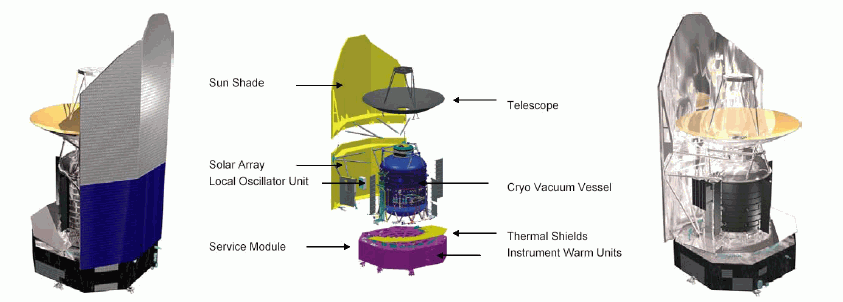
Figure 2.1. The Herschel spacecraft has a modular design. On the left, facing the "warm" side and on the right, facing the "cold" side of the spacecraft, the middle image names the major components.
Table 2.1. Herschel Spacecraft key characteristics
| S/C Type: | Three-axis stabilised |
| Operation: | Autonomous (3 hours daily ground contact period) |
| Dimensions: | 7.5 m high x 4.0 m diameter |
| Telescope diameter: | 3.5 m |
| Total mass: | 3170 kg |
| Solar array power: | 1500 W |
| Average data rate to instruments: | 130 kbps |
| Absolute pointing Error (APE): | 2.45 arcsec (pointing) / 2.54 arcsec (scanning) |
| Relative Pointing Error (RPE, pointing stability): | 0.24 arcsec (pointing) / 0.88 arcsec (scanning) |
| Spatial Relative Pointing Error (SRPE): | 2.44 arcsec |
| Cryogenic lifetime from launch: | min. 3.5 years |
So that the favourable conditions offered by being in space can be exploited to the full, Herschel carries a precision, stable, low background telescope (Figure 2.2). The Herschel telescope is passively cooled, allowing the size limitations imposed by active cooling to be overcome. Thus its diametre is only limited by the size of the fairing on the Ariane 5-ECA rocket. The Herschel telescope has a total wavefront error (WFE) of less than 6 μm (corresponding to "diffraction-limited" operation at < 90 μm) during operations. It also has a low emissivity to minimise the background signal, and the whole optical chain is optimised for a high degree of straylight rejection. In space the telescope cools radiatively, protected by a fixed sunshade, to an operational temperature in the vicinity of 85 K, with a uniform and very slowly changing temperature distribution.
The chosen optical design is a classical Cassegrain with a 3.5-m diameter primary and an "undersized" secondary. The telescope has been constructed almost entirely of silicon carbide (SiC). The primary mirror (M1) has been made out of 12 segments that have been brazed together to form a monolithic mirror, which was machined and polished to the required thickness (~3-mm) and accuracy. The secondary mirror (M2), with 308-mm diameter, has been manufactured in a single SiC piece. It is adjusted on the SiC barrel by tilt and focus adjustment shims. In order to avoid the Narcissus effect on the detectors, the central part of the secondary mirror is shaped in such a way that no parasitic reflected beam can enter the focal plane.
The hexapod structure (also made of SiC) supports M2 in a stable position with respect to M1. Finally, three quasi-isostatic bipods, made of titanium, support the primary mirror and interface with the cryostat. The focus is approximately one metre below the vertex of M1, inside the cryostat.
The proper telescope alignment and optical performance have been measured on ground in cold conditions. The measured wavefront performance in cold is in line with the requirements. In-flight results confirm the correctness of the focus position.
The M1 and M2 optical surfaces have been coated with a reflective aluminium layer, covered by a thin protective "plasil" (silicon oxide) coating. The telescope was initially kept warm after launch into space to prevent it acting as a cold trap while the rest of the spacecraft was cooling down.
Key telescope data are summarised in Table 2.2.
Table 2.2. The Herschel Telescope's predicted characteristics at working temperature (70 K)
| Configuration: | Cassegrain telescope |
| M1 Free diameter: | 3500-mm |
| Focal length: | 28500-mm |
| f-number: | 8.68 |
| Field of View radius: | 0.25° |
| M1 curvature radius / conic constant: | 3499.02-mm / -1 |
| Aperture stop / distance to M1 apex: | M2 mirror / 1587.555-mm |
| M2 diameter: | 308.11-mm |
| M2 curvature radius / conic constant: | 345.2-mm / -1.279 |
| Image diameter: | 246-mm |
| Image curvature radius / conic constant: | -165-mm / -1 |
| On-axis best focus distance to M1 vertex: | 1050-mm |
The Herschel cryostat houses the focal plane units of the three scientific instruments depicted in Figure 2.3. The cooling concept for the Herschel instruments is based on the proven principle used for the ISO mission. The temperature required in the instrument focal plane is provided down to 1.7K by a large superfluid helium Dewar (helium at 1.6K), sized for a scientific mission of 3.5 years. This is achieved with a total amount of 2160 litres of helium cryogen. The cryostat provides 1.7K as its lowest service temperature to the instruments. Further cooling down to 0.3K, required for two instruments (the SPIRE and PACS bolometers) is achieved by dedicated 3He sorption coolers that are part of the respective instrument focal plane unit. In orbit the liquid Helium is maintained inside the main tank by means of a phase separator (a sintered steel plug). The heat load on the tank will evaporate the Helium over the mission time at an estimated rate of about 200 grams per day. The enthalpy of the gas is used efficiently to cool parts of the instruments that do not require the low temperature of the tank (two temperature levels, at around 4K and around 10K). After leaving the instruments the evaporated gas is further used to cool the 3 thermal shields of the cryostat.
During ground operations, the vacuum vessel was closed by the means of a cover, located at its top, which was opened once in orbit. To maintain a cold environment inside the cryostat during the last few days before launch in Kourou, an auxiliary liquid Helium tank was used. The space side of the Cryostat Vacuum Vessel (CVV) is used as a radiator area to cool the CVV on orbit to a final equilibrium temperature of about 70K. This radiator area is coated with high emissive coating to achieve low temperatures in the L2 orbit. Multi-Layer-Insulation (MLI) covers the outer CVV-surfaces, in order to insulate it from the warm items (satellite bus and Sunshield). The outer layer of the MLI is optimised for the lowest temperature of the CVV. The outside of the cryostat is the mechanical and thermal mounting base for the Herschel telescope, the local oscillator unit of HIFI, the Bolometer Amplifier Unit of PACS and the large sunshield protecting the CVV from the sun.
The science payload is accommodated both in the "cold" (CVV) and "warm" (SVM) parts of the satellite. The instrument FPUs are located in the "cold" part, inside the CVV mounted on the optical bench, which is sitting on top of the superfluid helium tank. They are provided with a range of interface temperatures from about 1.7 K by a direct connection to the liquid superfluid helium, and additionally to approximately 4 K and 10 K by connections to the helium gas produced by the boil-off of liquid helium gas, which is used efficiently to provide the thermal environment necessary for their proper functioning. The "warm" - mainly electronics - parts of the instruments are located in the SVM. The following instruments are provided within the Herschel spacecraft:
The Photodetector Array Camera and Spectrometer (PACS)
The Spectral and Photometric Imaging REceiver (SPIRE)
The Heterodyne Instrument for the Far Infrared (HIFI)
The instruments are described in their respective users' manuals
The service module (SVM) is the box-type enclosure at the bottom of the satellite, below the EPLM and carries all spacecraft electronics and those instrument units that operate in an ambient temperature environment. It is depicted in Figure 2.4.
SVM modularity is achieved by implementing units of similar function on each of the panels. Panels are either dedicated to one instrument or to a single sub-system (Attitude Control, Power, Data handling-telecommunications). The propellant tanks are symmetrically implemented inside the central cone. The SVM also ensures the mechanical link between the launcher adapter and the EPLM.
The electrical power of the satellite is produced by the solar array. The solar array is in front of the cryostat to protect it from solar radiation. The rear of the sunshield is covered with multi layer insulation as is the part of the cryostat facing this warm part of the system. The geometrical design has to consider the size of the cryostat and the telescope, the required sun aspect angles of the s/c in orbit and the limited diameter of the fairing of the launcher. For Herschel a relatively simple system with a fixed solar array has been selected. The lower part actually carries the solar cells. The upper part is free of solar cells to allow it to be at a lower temperature, which in turn helps for the telescope to stay at the required temperature. The height of the sunshield is driven by the need to shade the entire telescope when the spacecraft is pointed closest to the sun (60° Sun aspect angle).
The Herschel s/c coordinate axis system is defined in [RD1] as follows:
The positive X-axis is perpendicular to the separation plane and nominally coincides with the longitudinal launcher axis. The positive X-axis shall be along the nominal optical axis of the Herschel telescope, towards the target source.
The Z-axis forms a plane with the X-axis perpendicular to the separation plane such that nominally the Sun lies in the XZ plane (zero roll angle), positive towards the Sun. In other words, the XZ plane is the symmetry plane of the solar array, the Z-axis pointing outwards from the solar array.
The Y-axis completes the right-handed orthogonal reference frame.
